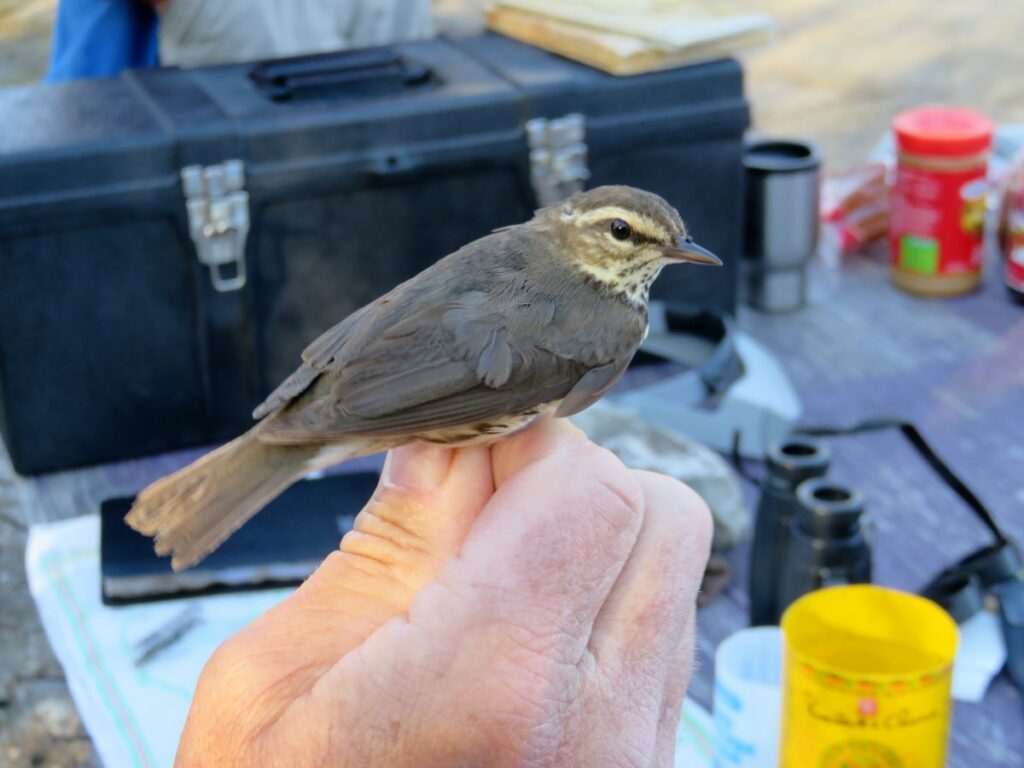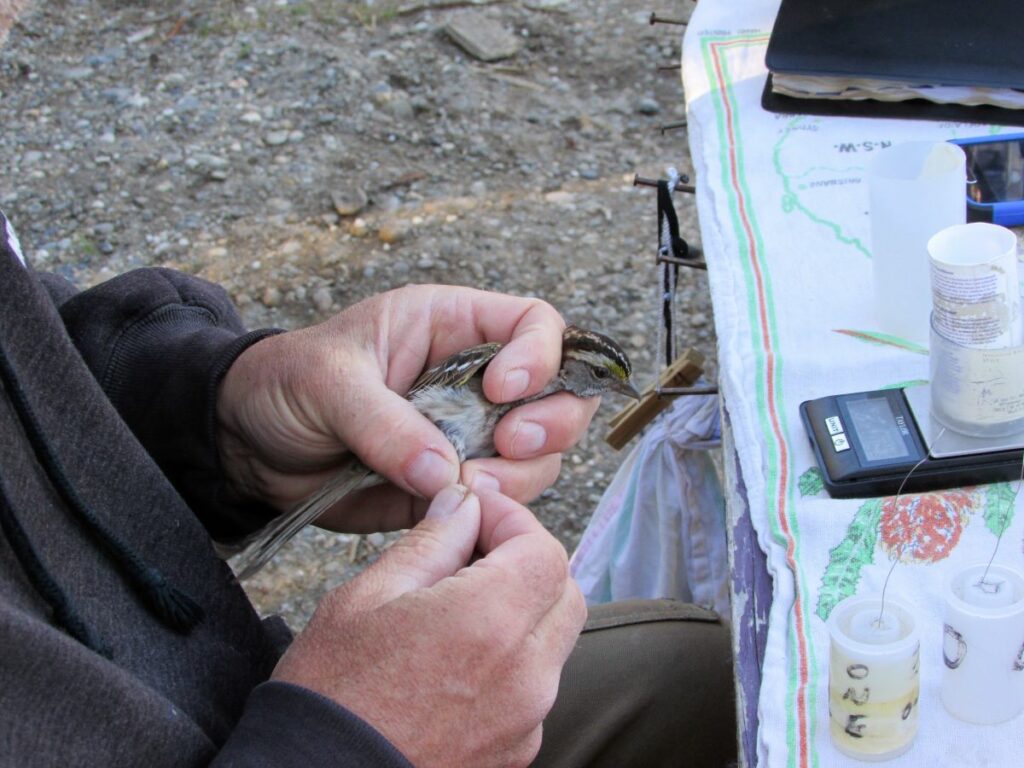The Alaska Highway, known as Highway 97 in British Columbia and Highway 1 in Yukon, meanders west along the 60th parallel, crossing it five times. Sometimes you’re in BC, sometimes in Yukon, and you might be forgiven for not always knowing which one you’re currently in. Leaving the town of Watson Lake behind, a careful observer might notice after 15 kilometres that a dirt track leads north into the low forest of sub-boreal pine and spruce.
Few take that turn, and it’s a pity they don’t, because hidden just a few minutes away, at the edge of where forest and wetland meet, something remarkable happens every spring, close to the Upper Liard River.
It’s a glorious morning, cold and calm. The sun was up at 5:00 a.m. (it’s mid-May), but there are still long shadows stretching across the highway at 7:00. The three-kilometre track is rutted with potholes and promises nothing, and we start wondering if we’re going to be able to turn around if it dead-ends.
Then, the dwarf trees thin and there’s a small parking area, a battered camping trailer, a table covered in clutter and a few people moving about, well wrapped-up in the dawn’s chill. Breath steams. In the patches of sun, the morning’s warmth on our faces feels good, but I wonder what the air temperature is. In the shadows near the table, mittened hands grasp pens awkwardly.
Welcome to the Albert Creek Bird Observatory (ACBO). A whiteboard shows the species seen at the site this spring. Another shows the number and type banded since May 22. It’s impressive. Kinglets, chickadees, warblers, sparrows, thrushes; the list is long. Even someone not interested in birds will have their curiosity piqued here—harriers, owls, ducks, herons, grouse.
Though they are clearly busy at the table, there are warm smiles when we approach, and we’re made to feel welcome immediately, just as long as we don’t get in the way. A man with a grizzled beard, wearing a thick fleece and wool toque looks up while holding a tiny yellow warbler in his hand. “I’m Ted,” he says.
We watch in silence as he opens the bird’s wing, calls out numbers (the wing feathers describe the bird’s age), then gently blows on its chest to separate the breast feathers. He calls out another number. “What’s that?” “It’s an estimate of the bird’s fat,” says Ted. “How much energy reserve does it have after its migration from the south?”
He reaches for a tiny metal band and crimping tool. It’s quickly clamped to the leg and its number recorded, before the bird is dropped head down into a narrow tube on a weigh scale. There’s no struggling. “8.5 grams,” he calls out. Andrea Sidler, the scribe, logs the numbers. In less time than it’s taken for you to read this, the bird has been fully documented. Ted lifts the confining tube, the bird slides out and is gone in a flash into the surrounding alder.
He reaches into the next soft bag, gently but firmly grasps the bird inside, and the process is repeated. This one’s a water thrush; the one after that a Lincoln sparrow. What comes across is just how quick and efficient the entire process is, with minimal stress on the bird.
When the bags are all empty, Ted glances at his watch. “Time to go,” he says. “Want to come?” We follow him on a trail out into the wetland to one of the mist nets. “We start at five o’clock every morning and stop at 10,” he explains. “To keep the stress on netted birds to a minimum, we check every net every half-hour.”
At the site there are two birds tangled in the fine mesh. Ted expertly removes the first, drops it into a cloth bag and puts a numbered peg on the bag’s mouth. “That’ll identify where we found it,” he says. Different nets are located in different habitats, so it’s important to record whether the bird was in the forest, or wetland, or on the margin between them.
The observatory began in 2001, and the site—Albert Creek—was chosen after consultation with a number of government and private ornithology experts. It has a good mix of wet and dry terrain, so attracts a wide variety of bird species.
Data from observation sites have limited value until there have been many years of records. Only then can trends start to develop, after seasonal variations have been smoothed out. Here on the BC-Yukon border, there’s been a 10 percent decline in rusty blackbirds over the past decade. Why? Conversely, red-wing blackbird numbers seem to be increasing. Again, why?
Ted explains that part of the challenge of placing nets in the same spots every year is that habitats change. Alder grows quickly, pine and spruce forests less so. What might have started in 2001 as a net over a shallow marsh might now be filled in and dry. Or be an alder thicket. The birds caught in that net will change. Is the increase or decline due to just that effect? Or is there an overall change that we should know about?
There are so many questions, at a time when we desperately need good data to make sound political decisions. Western Canada is woefully short of bird observation stations. Back at the tables, we meet another bearded giant, well wrapped up for the morning chill—Jukka Jantunen. We shake hands and I marvel how a massive maw like his can hold a nine-gram warbler so gently.
On the subject of bird observatories, Jukka shakes his head in disbelief. In his birth country of Finland, he explains, there are 15 stations in a country barely one third the size of BC. Here, there are just five. Money is tight. Nearly everything is done by volunteers, on a shoestring, but with a great degree of passion.
What else but passion could make these dedicated ornithologists spend six weeks in the most primitive conditions each spring, tracking the great bird migrations of North America? Their ‘home’ is a small, battered camping trailer, their workstation an open air table. They rise every morning before 5:00 a.m., and work through rain, sleet, cold or sun until 10:00, when they close the nets. It’s a form of enthusiasm that seems overwhelming, tinged with a deep respect for what they are doing.
Sometimes they work alone, when volunteers are short. Both Jukka and Ted spell each other off over the seven-week stretch from late April to early June each spring. Jukka is a professional bird contractor who is employed on projects across the north each summer—banding, observing, counting. “I work for bird seed!” He says with a laugh.
Ted is a medical orderly in Whitehorse. He takes all his leave each year so he can do the spring count. That’s tough on the family, he admits. The stipend doesn’t cover simple living expenses in the caravan—all of them pay out of pocket costs. Most of the observatory’s meagre funds are spent on new gear and travel. Ted says he’d like to do a fall banding program too, but there simply aren’t enough funds to do this equally important project during the autumn migration.
The same applies to the wooden boardwalks that once allowed dry access across the wetland. Many are 15 years old and showing their age, becoming more of a hazard than a help when you drop unexpectedly through to your thigh. Over the water, the consequences of a slip through a rotten plank are even more severe.
Starting an observatory takes considerable time, effort and red tape. Ted volunteered in the Toronto area for six years, including Long Point (the oldest bird observatory in the Western Hemisphere) before moving to Watson Lake with his wife in 1999. In 2001, he applied to Environment Canada for permission to start one on Albert Creek. There followed a succession of permits, site choices, equipment acquisitions and government certification. Now, as they approach the end of their second decade of recording, trends are appearing.
Nature is never static, even without the interference of humans. With the steady rise in temperatures worldwide, and particularly in the high latitudes, scientists estimate that habitats are moving northwards at 40 kilometres per decade, in some places even faster. Warm water turtles and great white sharks have been seen off Vancouver Island; butterfly fish and seahorses off Nova Scotia. Grassland birds are showing up in boreal forests.
Which species will be winners and losers in this race for survival? As the Red Queen observed in Alice’s Adventures in Wonderland, “… it takes all the running you can do, to keep in the same place. If you want to get somewhere else, you must run at least twice as fast as that!” Species must adapt faster and faster too.
An October 2019 report from the Audubon Society analyzed 140 million records from 70 data sources of over 600 species, and predicted that two thirds of North American birds are at risk of extinction by 2100. That’s if the US and Canada meet their Paris climate agreement goals. Dr Jeff Wells, VP of Audubon’s Boreal Conservancy, noted that northern species, especially Arctic birds, are particularly threatened. While temperate species may be able to adapt by breeding further north, there really isn’t anywhere for the millions of boreal forest and tundra dwellers to go. Data from sites like Albert Creek become more vital than ever.
On site, the latest batch of netted birds has been processed and released. Some, like Wilson’s warblers, may appear in the same net several times a season, some even several times in the same day. (Birds have bad days too, it seems.) It’s time to check the nets again. The routine is constant, every morning, for the first five hours of the day. On warmer mornings there are more bugs about, so there will be more birds in the mist nets. On colder mornings, there are fewer.
Small birds are easy to process, bigger species less so. Ted recalls a day when he was working alone and a northern harrier (a medium-sized raptor) ended up in a net. Disentangling it, while staying out of reach of its sharp beak and claws, was a challenge. Getting it weighed, banded and recorded back at the tables was even more so. Just as he was finishing, it flapped loose and sank its powerful talons into his thigh. It was Bactine and Band-Aid time.
Such are the joys and challenges at a bird observation station.



